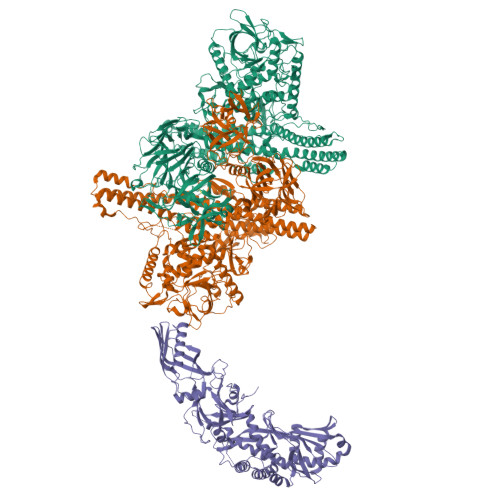Botulinum neurotoxins exploit host digestive proteases to boost their oral toxicity via activating OrfXs/P47.
Gao, L., Nowakowska, M.B., Selby, K., Przykopanski, A., Chen, B., Kruger, M., Douillard, F.P., Lam, K.H., Chen, P., Huang, T., Minton, N.P., Dorner, M.B., Dorner, B.G., Rummel, A., Lindstrom, M., Jin, R.(2025) Nat Struct Mol Biol
- PubMed: 39838108
- DOI: https://doi.org/10.1038/s41594-024-01479-0
- Primary Citation of Related Structures:
9ARJ, 9ARK, 9ARL - PubMed Abstract:
Botulinum neurotoxins (BoNTs) rank among the most potent toxins and many of them are produced by bacteria carrying the orfX gene cluster that also encodes four nontoxic proteins (OrfX1, OrfX2, OrfX3 and P47). The orfX gene cluster is also found in the genomes of many non-BoNT-producing bacteria, often alongside genes encoding oral insecticidal toxins. However, the functions of these OrfXs and P47 remain elusive. Here, we demonstrate that the combined action of all four components (OrfXs and P47) drastically boosts the oral toxicity of BoNT in mice, following proteolytic activation by digestive proteases that oral toxins regularly confront. In particular, OrfX2 adopts a self-inhibiting state, engaging with BoNT through another clostridial protein, nontoxic non-hemagglutinin (NTNH), only after proteolytic activation. Cryo-electron microscopy studies unveil that two molecules of protease-activated OrfX2 simultaneously associate with NTNH, a binding mode crucial for boosting BoNT oral toxicity. Collectively, these studies offer novel insights into the physiological functions and regulatory mechanisms of OrfXs and P47 of BoNTs, shedding light on the pathogenesis of other bacterial toxins associated with homologous OrfXs and P47.
Organizational Affiliation:
Department of Physiology and Biophysics, University of California, Irvine, Irvine, CA, USA.




















